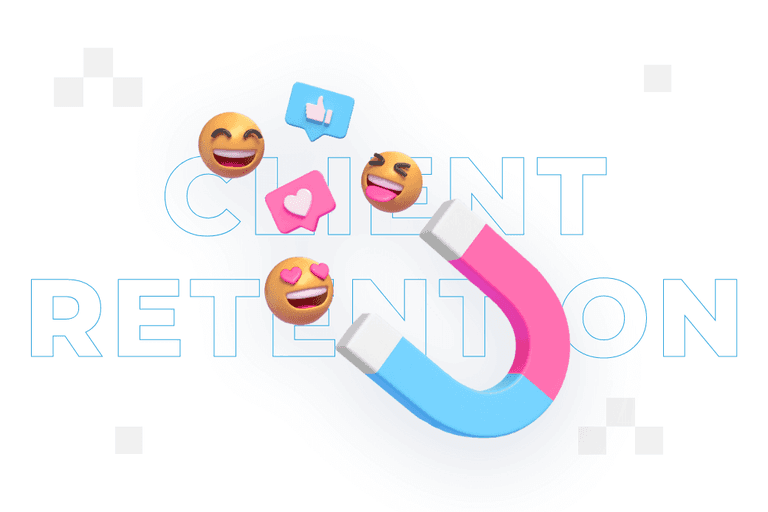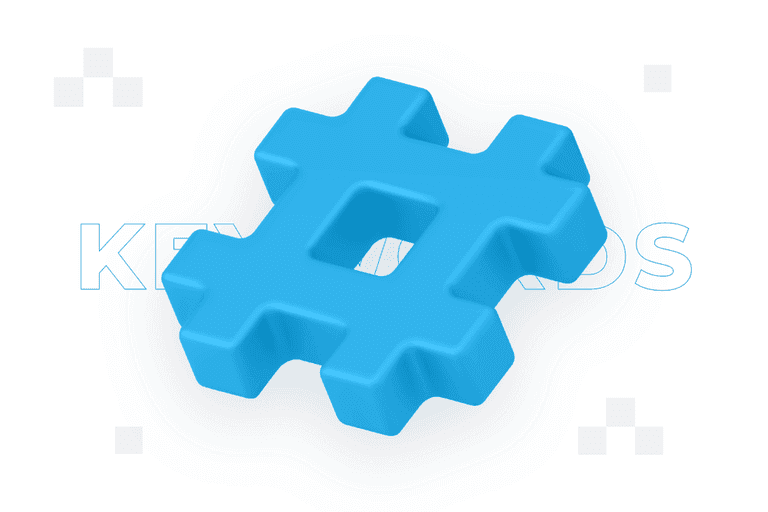Table of contents

Client retention – what can be done to keep customers coming back?

Although new customers are extremely important for the growth of a business, acquiring customers is often much more expensive than retaining those who have already made a purchase. What’s more, a satisfied customer who decides to use our services again usually tends to spend more and is more likely to recommend our products or services to others, thus becoming an extremely effective natural brand ambassador. So what strategy will help to retain customers?
In this article you will find out:
- What is customer retention?
- What is a customer retention rate and how to calculate it?
- What are effective customer retention strategies?
- Why and how to measure customer satisfaction?
Customer retention – definition
Customer retention, also known as customer retention, is the strategies and tactics used to retain as many customers as possible for as long as possible. In other words, it is the process of building lasting relationships with customers and keeping them happy and interested in what your business has to offer them.
Customer retention, also known as customer relationship management (CRM), is the process of building and maintaining lasting and beneficial relationships with customers throughout the customer lifecycle and their interactions with your business. The goal of customer retention is to increase customer loyalty, enhance customer lifetime value and generate repeat business.
Customer retention definition
Retaining existing customers is based on understanding what they need and expect, and meeting and exceeding those expectations. Many entrepreneurs see customer retention as a key part of their business strategy. This is because customer retention is often associated with a better understanding of customers, which ultimately leads to higher profits.
Customer retention rate
Customer retention rate is a metric that allows companies to determine what percentage of consumers stay with them for a certain period of time. This indicator is calculated using the following formula:
Number of total customers : number of customers who chose to buy again * 100%Obviously, a high customer retention rate is desirable – it means that the majority of customers remain in contact with the company and continue to be interested in its products/services, indicating the effectiveness of the activities carried out so far.
Customer retention strategies
To be successful, you will need to implement the right strategy to successfully retain customers. Here are the best practices for doing so:
Understanding the customer
If you aim to retain customers, you must first and foremost understand their needs and expectations. Companies that have a strong understanding of their consumers are better equipped to meet and exceed their expectations, leading to greater customer satisfaction, loyalty and, ultimately, retention. Understanding the customer, however, requires the systematic collection, analysis and interpretation of data, concerning the target group.
So what information is most important? This depends on the specific company and its offering. However, there are a few categories that are valuable to most businesses. These include:
- demographic data – age, gender, geographical location,
- psychographic data – lifestyles, interests, values,
- behavioural data – purchase histories, interactions with the business, website browsing.
Collecting this data allows you to create a customer profile, which in the next stage can be used to tailor your commercial offer to the needs and expectations of a specific consumer. For example, you may notice that your younger customers prefer to shop online and are active on social media, while older customers prefer to shop in a stationary shop and use traditional customer service. Knowing this will allow you to tailor your communications and offerings to the preferences of each audience segment, making it more likely that they will stay with you for longer.
High quality product/service
Another key element is the high quality of your product or service. This is because many consumers are not content with average quality and are looking for products and services that go far beyond their expectations. If you consistently provide products or services that are of high quality, you will win the trust of your customers, which will translate into their long-term loyalty and therefore make them eager to return to you.
The quality of a product/service covers many aspects. At the product level, quality can refer to, for example, durability, usability, performance, and other physical characteristics of the product. In the case of services, quality may include, for example, the availability of the service and its compliance with customer expectations.
Consistently providing quality products or services requires constant monitoring and improvement of your offering. To do this, you can use regular quality surveys, reading customer feedback and reacting quickly to problems as they arise. In the context of a high-quality product or service, it is also extremely important to innovate. This will provide your customers with new, even better solutions. This will give you a competitive advantage and encourage consumers to use your offer again.
Excellent customer service
Excellent customer service largely determines your sales success. It is the element that differentiates your business, contributes to building long-term relationships with your customers and leads to increased customer loyalty.
When we talk about excellent customer service, it is about meeting and exceeding customer expectations, at every stage of interaction with the company. Remember that customer service goes far beyond solving problems and answering questions. It also encompasses proactively anticipating customer needs, offering assistance before consumers ask for it and providing added value to customers that increases their level of satisfaction.
Loyalty programmes
Loyalty programmes are about building relationships with customers by rewarding them for frequent purchases or interactions with the brand. Loyalty programmes make customers feel valued, which increases their satisfaction and encourages them to use your services again.
An effective loyalty programme consists of several key elements:
- Valuable rewards – the rewards, offered as part of a loyalty programme, must be attractive to customers. They can be discounts, free products, exclusive offers or access to special events. It is important that the rewards are valuable enough to motivate customers to buy again.
- Simplicity – a loyalty programme should be designed in such a way that the customer has no problem understanding its rules and using it. Programs that are too complex may put consumers off.
- Personalisation – loyalty programmes should offer personalised rewards and offers – based on a customer’s preferences and purchase history. This will make them feel valued and understood, which will increase their trust and loyalty to the brand.
- Communication – when introducing a loyalty programme, you need to communicate regularly with participants about their status in the programme, available rewards and special promotions. Well-designed communication can increase consumer engagement and encourage them to use the programme.
- Accessibility – ensure that the loyalty programme you create is easily accessible to customers – regardless of how they shop (the programme should include online shopping, in-store shopping or shopping via a mobile app).
Personalisation
With personalisation, you can tailor your products and services to your customers’ individual needs and preferences. This strategy shows consumers that you understand and value them, which increases engagement and loyalty.
Personalisation can take different forms, depending on the specifics of your business and the characteristics of your target audience. It can include customising your products or services, or personalising your customer communications (for example, through personalised emails or social media messages). Remember to base your actions on real data about your customers and their preferences, rather than your own guesswork.
Technology plays a big role in personalisation. Tools such as data analytics, artificial intelligence and machine learning, among others, will help. With these, you can collect and analyse large amounts of customer data and then use it to tailor offers to individual customer needs and preferences. For example, with the help of analytics technologies, you will be able to understand what products or services are most popular with certain groups of customers. This will allow you to tailor your offerings to the preferences thus defined.
Feedback and reviews
Before customers make purchasing decisions, they often look to other people’s opinions first. For this reason, positive reviews and feedback can make a significant contribution to attracting new customers and retaining existing ones.
Here are some ways you can use feedback and reviews to help retain existing customers:
- Build trust – customers often trust other consumers’ reviews far more than they trust product advertisements. For this reason, encouraging satisfied customers to leave positive reviews will be a very effective tool for increasing customer loyalty.
- Getting feedback – feedback and reviews are also a great source of customer feedback. From them, you can find out what your consumers like and what areas need improvement. This will give you the chance to make appropriate changes, allowing you to effectively meet your customers’ expectations.
- Encourage repeat purchases – you can share positive feedback and reviews across your communication channels. For example, a good solution would be to include them on your website, on social media or in your newsletter. This will encourage your customers to buy again.
Building customer relationships
Beyond just selling your products or services, you must strive to build relationships that will ensure your customers’ loyalty in the long run. How do you build valuable relationships? First and foremost:
- Know your customers – the basis for building lasting relationships is to understand your customers’ needs, expectations and preferences. Analysing customer data, conducting surveys, reviewing feedback and comments, and communicating directly with your customers will help you do this.
- Deliver value – customers value companies that provide them with real value – not just quality products or services, but also help, support, educational content and even entertainment. Delivering value should therefore be an ongoing part of your customer interaction.
- Communicate effectively – regular, clear and honest communication with your customers can include keeping them informed, answering questions, solving problems and sharing interesting content or news. In this way, you will show your customers that you remember them.
- Show that you care about your customers – thanking them for their purchase, special offers for regular customers or informing them about special occasions will help.
- Listen and respond to feedback – by actively listening to your customers and responding to their comments – both positive and negative, you show that you respect your customers and are willing to improve your offering – to better meet their expectations.
Remember that building relationships with your customers is a long-term process that requires ongoing commitment. However, its results can be very rewarding and lead to increased customer loyalty, increased sales and even the transformation of customers into brand ambassadors.
Measuring customer satisfaction
Measuring satisfaction through a customer satisfaction survey is the collection and analysis of information about how consumers perceive your company’s products or services. It is a key tool for customer retention as it allows you to understand their needs and expectations and identify areas for improvement. Satisfied customers, on the other hand, are more likely to make repeat purchases and recommend the company to others, which contributes to its long-term success.
Here are the key methods for measuring customer satisfaction:
- Surveys – can include questions, such as overall satisfaction with the product or service, satisfaction with customer service, satisfaction with the buying process or other aspects, related to the customer experience. You can conduct surveys in a variety of ways – by email, phone, website or social media.
- Customer feedback – both formal and informal – is a valuable source of information on customer satisfaction. You can collect these through online reviews, comments on social media or feedback given directly to the business.
- Customer behaviour analysis – observing customer behaviour can provide you with a wealth of information about customer satisfaction. You can use various analytical tools (both online and offline) to do this.
Be sure to use customer satisfaction information appropriately. You should use this information to identify areas for improvement, create better products or services, improve your customer service and make strategic business decisions. It will also be important to communicate with your customers once you have made the necessary changes. This will show that you value your consumers’ opinions and strive to meet their needs.
Contact form
Develop your brand
Rate content:
You may be interested in:




